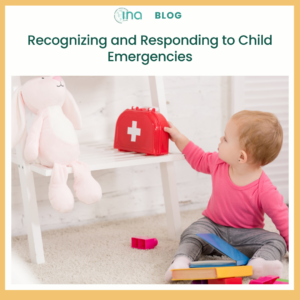 By Katie Brenneman
By Katie Brenneman
The children you nanny mean the world to you, and you’d do anything to keep them safe. Unfortunately, emergencies do occur at times, and their overall safety is dependent on you properly acknowledging the situation and reacting accordingly. With the information below, you’ll gain some insight into common childhood emergencies, how to respond to them, and ways to prepare for these occurrences.
Identifying Common Medical Emergencies & Providing Care
Though the majority of your time as a nanny has likely been free of major disasters, having a considerable understanding of medical emergency signs will save you a great deal of stress, not to mention preserving the safety of the children you care for.
Allergic Reactions
A common medical emergency is an allergic reaction. These reactions can be caused by numerous things, such as medicines, foods, insects, latex, pets, or pollen. Allergic reactions vary in severity, but a reaction that indicates an emergency typically manifests as breathing difficulties, severe skin rash, vomiting, or swelling of the eyes or throat.
When responding to a severe allergic reaction, keep the child calm and call emergency services. If necessary, administer an EpiPen. Should the child vomit during the reaction, turn them to the side and try not to lift their head or give them medications by mouth. To avoid any potential reactions, steer clear of outdated childcare tactics and remedies. For example, many teething gels that consist of benzocaine can cause potentially fatal reactions. Though these gels were once commonly used, the FDA has since warned of the dangers of this treatment. Keeping yourself well-informed about these known dangers can prevent you from experiencing an allergy-related emergency.
Choking
There is a vast difference between a child who is merely coughing and a child who is choking. Remember, coughing is loud, but choking is generally soundless. A child may also turn blue while choking due to airway restriction. Assist the child by immediately calling emergency services and helping them cough. If this doesn’t work, perform abdominal thrusts until the object dislodges.
Mental Health Emergencies
Though you should always be on the lookout for physical emergencies as a caregiver, mental health issues and crises should be acknowledged similarly. When caring for a child, keep an eye out for any key indicators of anxiety, depression, or similar behavioral cues that may lead to self-harm or put the child in danger.
Many children spend a lot of time online as well – supervising internet usage can help you identify cyberbullying or other harmful or predatory relationships young children can be susceptible to engaging in. Routinely ask the children who they talk to online and be aware of what sites they frequent. To keep unsupervised internet use to a minimum and offer an abundance of offline, structured activities for the children to take part in, such as art projects or board games.
Preparing for Child Emergencies
Staying informed and prepared when it comes to child emergencies can save lives. One of the best ways to keep the children in your care safe is to receive CPR certification. With a CPR certification, you’ll learn how to properly administer care in the event of choking, drowning, or cardiac arrest. Parents will appreciate this knowledge, boosting your job prospects, and you can care for children confidently knowing you can react properly during an emergency.
Another key way to prepare for emergencies is to have clear communication with the child’s parents as to their medical history and capabilities. When joining a new family as a nanny, be sure to ask about allergies, eating habits, swimming ability, and any other topic that may pose a potential threat to the child’s safety. Be sure to have a reliable means of contact between you, emergency services, and the child’s parents at all times.
Katie Brenneman is a passionate writer specializing in lifestyle, mental health, education, and fitness-related content. When she isn’t writing, you can find her with her nose buried in a book or hiking with her dog, Charlie. To connect with Katie, you can follow her on Twitter.
